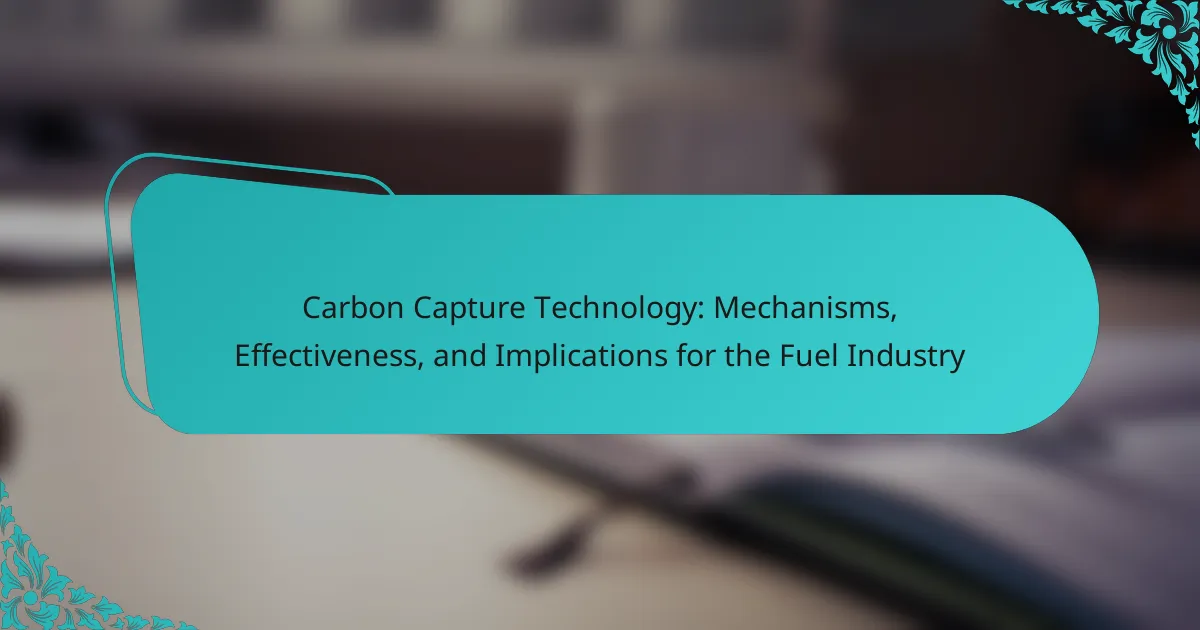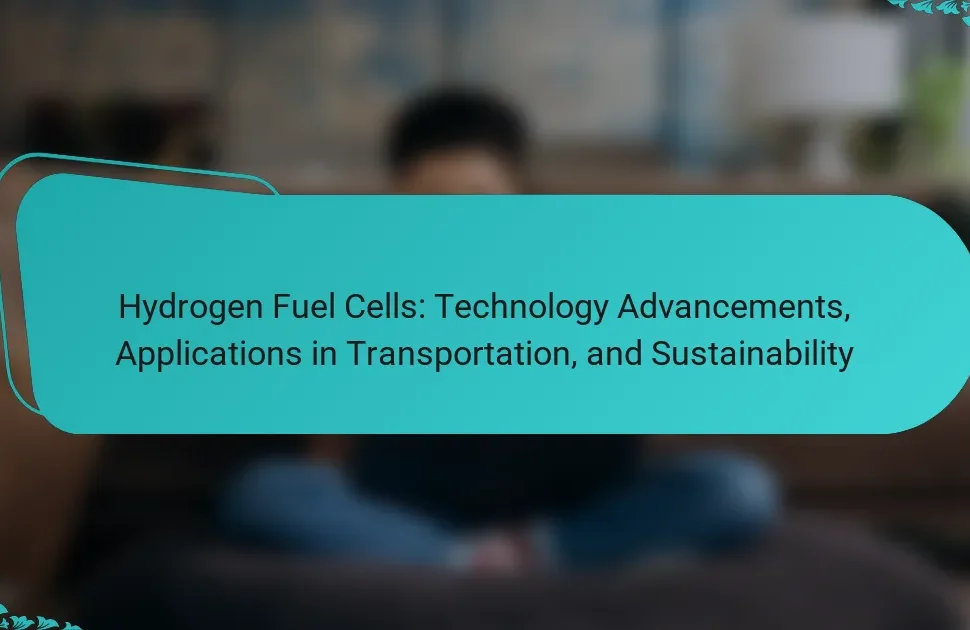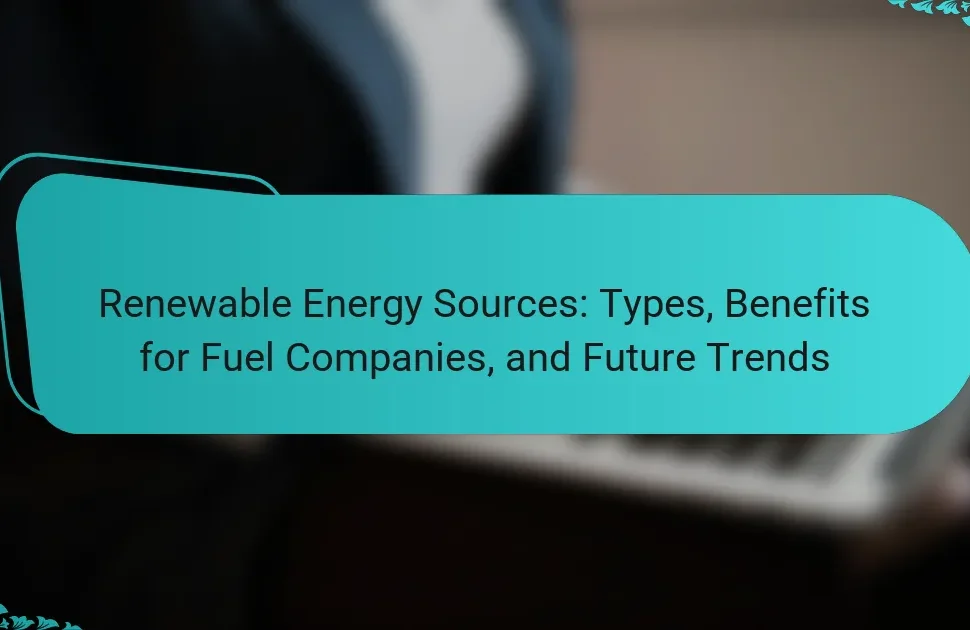
What is Carbon Capture Technology?
Carbon capture technology is a process designed to capture carbon dioxide emissions from sources like power plants. It prevents CO2 from entering the atmosphere, thereby reducing greenhouse gas emissions. The captured CO2 can be stored underground or utilized in various industrial processes. This technology is critical in combating climate change. According to the International Energy Agency, carbon capture could contribute to achieving net-zero emissions by 2050.
How does Carbon Capture Technology function?
Carbon capture technology functions by extracting carbon dioxide (CO2) emissions from industrial processes and power generation. This process typically involves three main steps: capture, transport, and storage. During capture, CO2 is separated from other gases using various methods, such as chemical absorption or membrane separation. The captured CO2 is then compressed and transported, often via pipelines, to a storage site. Finally, the CO2 is injected into geological formations for long-term storage, preventing its release into the atmosphere. Studies show that carbon capture can reduce emissions by up to 90% in certain applications, demonstrating its effectiveness in mitigating climate change.
What are the key processes involved in Carbon Capture Technology?
The key processes involved in Carbon Capture Technology are absorption, adsorption, membrane separation, and cryogenic separation. Absorption utilizes solvents to capture carbon dioxide from gas streams. This process often employs amine solutions, which react with CO2 to form a compound. Adsorption involves solid materials that bind CO2 molecules onto their surface. Common adsorbents include zeolites and activated carbon. Membrane separation uses selective barriers to separate CO2 from other gases based on size or solubility. Cryogenic separation cools gas mixtures to liquefy CO2, allowing for its collection. Each of these processes is designed to reduce greenhouse gas emissions effectively.
What types of carbon capture methods exist?
There are several types of carbon capture methods. These methods include direct air capture, post-combustion capture, pre-combustion capture, and oxy-fuel combustion. Direct air capture involves extracting CO2 directly from the atmosphere. Post-combustion capture captures CO2 from flue gases after fossil fuels are burned. Pre-combustion capture separates CO2 before combustion, typically in gasification processes. Oxy-fuel combustion uses pure oxygen instead of air, resulting in a concentrated CO2 stream. Each method has unique applications and efficiencies in reducing greenhouse gas emissions.
What are the main benefits of Carbon Capture Technology?
Carbon Capture Technology offers significant benefits for reducing greenhouse gas emissions. It captures carbon dioxide emissions from sources like power plants and industrial processes. This technology prevents CO2 from entering the atmosphere. According to the International Energy Agency, carbon capture could reduce global emissions by up to 14% by 2030. It also enables the continued use of fossil fuels while mitigating climate change. Additionally, captured CO2 can be utilized in various applications, such as enhanced oil recovery. This process not only sequesters carbon but can also increase oil production efficiency. Furthermore, carbon capture can stimulate job creation in new technology sectors.
How does Carbon Capture Technology contribute to reducing greenhouse gas emissions?
Carbon capture technology reduces greenhouse gas emissions by capturing carbon dioxide (CO2) from industrial processes and power generation. This technology prevents CO2 from entering the atmosphere. It involves capturing CO2 at its source, compressing it, and storing it underground or using it in other processes. Studies show that carbon capture can reduce emissions by up to 90% in certain applications. For instance, the Petra Nova project in Texas captures 1.6 million tons of CO2 annually. This technology is crucial for meeting global climate targets and mitigating climate change impacts.
What economic advantages does Carbon Capture Technology provide?
Carbon Capture Technology provides significant economic advantages by reducing greenhouse gas emissions and enabling compliance with regulations. It lowers the carbon footprint of industries, which can lead to cost savings in carbon taxes and penalties. The technology also allows companies to enhance their sustainability profiles, attracting environmentally conscious investors. Furthermore, capturing CO2 can be repurposed for various industrial processes, creating new revenue streams. According to the International Energy Agency, implementing carbon capture could generate up to $1 trillion in economic opportunities by 2030. This technology can also stimulate job creation in engineering, manufacturing, and maintenance sectors.

What is the effectiveness of Carbon Capture Technology?
Carbon Capture Technology (CCT) effectively reduces greenhouse gas emissions. It captures up to 90% of carbon dioxide emissions from industrial sources. CCT is implemented in facilities like power plants and cement factories. The technology uses various methods, including absorption, adsorption, and membrane separation. According to the International Energy Agency, CCT could contribute to 14% of the emissions reduction needed by 2050. The effectiveness varies based on the technology used and the application context. Continuous advancements improve its efficiency and cost-effectiveness. Overall, CCT plays a crucial role in mitigating climate change impacts.
How efficient is Carbon Capture Technology in various applications?
Carbon Capture Technology has varying efficiency depending on its application. In industrial processes, it can capture up to 90% of CO2 emissions. For power generation, efficiency typically ranges from 60% to 90%. Factors affecting efficiency include the type of capture method used and the specific industrial context. For example, post-combustion capture in coal plants shows higher efficiency with advanced solvents. In contrast, direct air capture technologies achieve lower efficiency, around 50%. The overall effectiveness is also influenced by the purity of the CO2 stream and operational conditions. These efficiencies are supported by studies, such as the Global CCS Institute report, which highlights the performance metrics across different sectors.
What factors influence the efficiency of Carbon Capture Technology?
The efficiency of Carbon Capture Technology is influenced by several key factors. These include the type of capture technology used, such as absorption, adsorption, or membrane separation. Each method has varying efficiencies based on design and operational parameters. The concentration of CO2 in the flue gas also plays a significant role. Higher concentrations typically lead to more effective capture rates.
Temperature and pressure conditions during the capture process can impact efficiency as well. Optimal conditions vary depending on the technology employed. The presence of impurities in the gas stream can hinder the performance of capture systems. Additionally, the energy requirements for the capture process affect overall efficiency.
Recent studies indicate that advancements in materials and processes can enhance capture rates. For example, research published in the journal “Nature” highlights the role of novel sorbents in improving efficiency. Overall, these factors collectively determine the effectiveness of Carbon Capture Technology in reducing CO2 emissions.
How does the effectiveness of Carbon Capture Technology compare to other methods?
Carbon Capture Technology (CCT) is generally more effective than many traditional methods of reducing carbon emissions. CCT can capture up to 90% of carbon dioxide emissions from industrial sources. In contrast, methods like reforestation and renewable energy adoption have lower capture rates. For example, reforestation can only absorb approximately 10% of annual emissions. Additionally, renewable energy technologies reduce emissions but do not capture existing CO2. CCT also allows for continued use of fossil fuels while mitigating their impact. Studies show that large-scale deployment of CCT could reduce global emissions by 14% by 2030. Therefore, CCT stands out as a crucial technology in the fight against climate change.
What challenges does Carbon Capture Technology face?
Carbon Capture Technology faces several significant challenges. High costs are a primary concern, as capturing and storing carbon can be expensive. Efficiency is another challenge; current technologies often capture only a fraction of emitted carbon dioxide. Infrastructure limitations also hinder widespread implementation. Many facilities lack the necessary systems to integrate carbon capture. Regulatory frameworks are often unclear or inconsistent, creating uncertainty for investors. Public perception and acceptance can pose barriers to deployment. Additionally, the long-term storage of captured carbon raises environmental and safety concerns. These challenges collectively impact the scalability and viability of carbon capture solutions.
What are the technological limitations of Carbon Capture Technology?
Carbon Capture Technology faces several technological limitations. High energy consumption is a significant barrier, as capturing carbon requires substantial power input. Current methods often rely on solvents that can degrade over time, leading to increased costs and maintenance. The capture efficiency varies significantly between different technologies, with some methods capturing less than 50% of emissions. There is also a lack of infrastructure for transporting and storing captured carbon dioxide safely. Additionally, scalability remains an issue, as many existing technologies are not yet proven at large industrial scales. These limitations hinder the widespread adoption of carbon capture solutions in the fuel industry.
How do regulatory and policy issues impact Carbon Capture Technology?
Regulatory and policy issues significantly impact Carbon Capture Technology by influencing investment, deployment, and operational frameworks. Clear regulations can provide financial incentives, such as tax credits or grants, which encourage companies to adopt these technologies. For instance, the U.S. 45Q tax credit offers up to $50 per ton for captured carbon dioxide, promoting investment in capture projects. Conversely, ambiguous or restrictive regulations can hinder technology development and implementation. Policies that set stringent emissions targets can drive demand for carbon capture solutions. Additionally, international agreements, like the Paris Agreement, can shape national policies that support or challenge carbon capture initiatives. Overall, effective regulatory frameworks can enhance the viability and scalability of Carbon Capture Technology, while poor policies can stifle innovation and progress.

What are the implications of Carbon Capture Technology for the fuel industry?
Carbon Capture Technology (CCT) significantly impacts the fuel industry by reducing greenhouse gas emissions. This technology captures carbon dioxide produced during fuel combustion. It can help the industry comply with stricter environmental regulations. CCT promotes the transition to cleaner energy sources. According to the International Energy Agency, CCT can reduce emissions by up to 90%. This can enhance the sustainability of fossil fuel usage. Additionally, it may create new market opportunities for carbon credits. Overall, CCT is crucial for mitigating climate change while maintaining fuel production.
How can Carbon Capture Technology reshape the fuel industry?
Carbon capture technology can significantly reshape the fuel industry by reducing greenhouse gas emissions. This technology captures carbon dioxide produced from fuel combustion before it enters the atmosphere. It can be integrated into existing power plants and industrial processes, making it a viable option for reducing carbon footprints. According to the International Energy Agency, implementing carbon capture could lead to a 14% reduction in global CO2 emissions by 2030. Furthermore, capturing and utilizing CO2 can create new markets for carbon dioxide, such as in enhanced oil recovery. This approach not only mitigates climate change but also promotes sustainable fuel production.
What role does Carbon Capture Technology play in transitioning to sustainable fuels?
Carbon Capture Technology plays a crucial role in transitioning to sustainable fuels by reducing carbon dioxide emissions from fossil fuel use. This technology captures CO2 emissions at their source, preventing them from entering the atmosphere. The captured CO2 can be utilized in the production of synthetic fuels, which are more environmentally friendly. According to the International Energy Agency, implementing carbon capture could reduce emissions by up to 14% by 2030. Additionally, this technology supports the development of a circular carbon economy, where captured CO2 is recycled into usable energy sources. By facilitating the integration of renewable energy, carbon capture enhances the viability of sustainable fuels.
How does Carbon Capture Technology affect fuel production processes?
Carbon capture technology significantly impacts fuel production processes by reducing greenhouse gas emissions. It captures carbon dioxide produced during fuel combustion or industrial processes. This captured CO2 can be stored underground or utilized in various applications, such as enhanced oil recovery. By integrating carbon capture, fuel producers can comply with regulatory standards and achieve sustainability goals. The technology can also improve the overall efficiency of fuel production. Studies show that carbon capture can reduce emissions by up to 90% in certain processes. This reduction helps mitigate climate change effects while maintaining energy production. Therefore, carbon capture technology is essential for transitioning to a low-carbon fuel industry.
What are the future prospects of Carbon Capture Technology in the fuel industry?
The future prospects of Carbon Capture Technology in the fuel industry are promising. This technology aims to reduce greenhouse gas emissions from fuel production and consumption. It helps mitigate climate change by capturing carbon dioxide before it enters the atmosphere. Major companies are investing in carbon capture projects. For instance, the Global CCS Institute reported that over 260 large-scale carbon capture projects are in development worldwide. Enhanced oil recovery techniques also utilize captured carbon dioxide, improving oil extraction efficiency. Additionally, government policies increasingly support carbon capture initiatives, providing funding and incentives. These factors indicate a growing role for carbon capture in the fuel industry.
What innovations are being explored to enhance Carbon Capture Technology?
Innovations in Carbon Capture Technology include advanced materials, improved processes, and integration with renewable energy. Researchers are exploring new sorbents that enhance CO2 absorption efficiency. Membrane technology is being developed to separate CO2 from other gases more effectively. Direct air capture systems are also being refined to lower operational costs. Hybrid systems that combine different capture methods are under investigation for increased efficiency. Additionally, utilizing waste heat in carbon capture processes is being studied to improve energy efficiency. These innovations aim to make carbon capture more viable and scalable.
How can stakeholders collaborate to advance Carbon Capture Technology?
Stakeholders can collaborate to advance Carbon Capture Technology by forming partnerships and sharing resources. Industry leaders can invest in research and development initiatives together. Governments can create supportive policies and funding opportunities. Academic institutions can contribute innovative research and technological advancements. Sharing data and best practices among stakeholders enhances efficiency and effectiveness. Collaborative pilot projects can demonstrate real-world applications and scalability. Joint ventures can reduce financial risks associated with new technologies. Public-private partnerships can leverage strengths from both sectors to accelerate progress.
What best practices should be followed when implementing Carbon Capture Technology?
Implementing Carbon Capture Technology requires several best practices. First, conducting a thorough site assessment is essential. This assessment identifies the most suitable locations for installation. Next, selecting the appropriate capture technology is crucial. Different processes, such as post-combustion and pre-combustion capture, suit various applications.
Additionally, integrating the capture system with existing infrastructure enhances efficiency. This integration minimizes disruptions and maximizes resource use. Regular maintenance and monitoring of the capture systems ensure optimal performance. Scheduled checks can prevent potential failures and improve longevity.
Furthermore, engaging stakeholders early in the process fosters collaboration. This involvement helps address concerns and aligns goals. Finally, adhering to regulatory frameworks is vital. Compliance ensures that operations meet environmental standards and public expectations. These best practices contribute to the effective implementation of Carbon Capture Technology.
Carbon Capture Technology (CCT) is a process that captures carbon dioxide emissions from sources like power plants to mitigate climate change. The article explores the mechanisms of CCT, including key processes such as absorption, adsorption, and membrane separation, and discusses various capture methods like direct air capture and post-combustion capture. It also highlights the effectiveness of CCT in reducing greenhouse gas emissions, its economic advantages, and the challenges it faces, including technological limitations and regulatory issues. Furthermore, the implications of CCT for the fuel industry are examined, focusing on its role in transitioning to sustainable fuels and the innovations being explored to enhance its efficiency and scalability.




